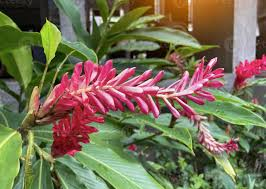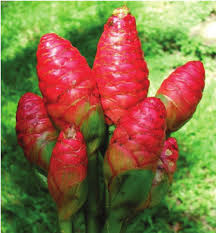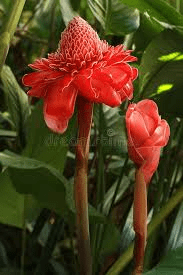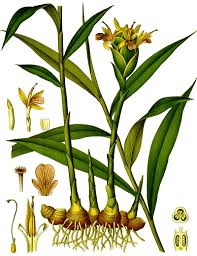Ginger inflorescence, the flowering part of the ginger plant (Zingiber officinale), is a fascinating botanical feature that plays a crucial role in the plant’s reproductive cycle. Understanding the structure, characteristics, and uses of ginger inflorescence can provide a deeper appreciation of this versatile plant.
The inflorescence of the ginger plant typically emerges from the base of the plant and consists of a cluster of flowers arranged on a central spike. This spike, or rachis, is often surrounded by bracts, which are modified leaves that protect the developing flowers. The bracts can be colorful, ranging from green to red or purple, and contribute to the overall ornamental appeal of the inflorescence.
Ginger flowers themselves are small, tubular, and usually white or yellow, though they can vary in color depending on the specific variety of ginger. Each flower is delicate and short-lived, but collectively, the inflorescence can remain attractive for several weeks. The arrangement of the flowers on the spike is known as a raceme, a type of inflorescence where the flowers are attached by short stalks along the central axis.
The primary function of the ginger inflorescence is reproduction. In the wild, ginger plants rely on pollinators such as bees and other insects to transfer pollen from one flower to another, facilitating fertilization and the production of seeds. However, cultivated ginger is usually propagated vegetatively through its rhizomes, so the role of the inflorescence in commercial ginger farming is often less emphasized.
Despite this, ginger inflorescence has notable culinary and ornamental uses. In culinary contexts, the young, tender inflorescence can be harvested and used as a vegetable, particularly in Southeast Asian cuisines. It has a mild, slightly spicy flavor and a crunchy texture that can enhance salads, soups, and stir-fries. The inflorescence can also be pickled, adding a unique gingery flavor to dishes.
In addition to its culinary applications, ginger inflorescence is valued for its ornamental qualities. The vibrant bracts and delicate flowers make it a popular choice for floral arrangements and garden decorations. The inflorescence can be cut and used in fresh floral displays or dried for long-lasting arrangements. Its exotic appearance adds a touch of tropical elegance to any setting.
Medicinally, the ginger inflorescence shares some of the beneficial properties of the ginger rhizome, though it is generally used less frequently. The flowers and bracts contain antioxidants and other bioactive compounds that contribute to ginger’s overall health benefits. Infusions or teas made from the inflorescence can provide mild anti-inflammatory and digestive benefits, similar to those of the rhizome.
Growing ginger to encourage the development of its inflorescence requires the same conditions as cultivating it for its rhizomes. The plant thrives in warm, humid environments with well-drained soil and partial shade. Proper care, including regular watering and adequate nutrients, will promote healthy growth and flowering. Ginger plants typically begin to flower after about 10 months to a year of growth.
Ginger inflorescence is a remarkable part of the ginger plant, offering both aesthetic and practical benefits. Its structure and beauty make it an attractive addition to gardens and floral arrangements, while its mild flavor and health benefits add culinary and medicinal value. By exploring the uses and appreciating the characteristics of ginger inflorescence, one can gain a more comprehensive understanding of the versatility and appeal of the ginger plant.
The Economic Importance and Uses of Ginger Inflorescence

1. Medicinal Uses: Ginger inflorescence is used in traditional medicine to treat ailments such as inflammation, digestive issues, and respiratory problems. For example, ginger inflorescence tea is known to soothe sore throats.
2. Culinary Uses: Ginger inflorescence is used in culinary dishes for its aromatic properties. In Southeast Asian cuisine, it is often added to soups and salads for flavor and garnish.
3. Essential Oils: Ginger inflorescence essential oils are extracted for use in aromatherapy and perfumery. These oils are known for their calming and anti-inflammatory properties.
4. Ornamental Uses: Ginger inflorescence is popular in floral arrangements and landscaping due to its vibrant colors and exotic appearance.
5. Cosmetic Industry: Extracts from ginger inflorescence are used in skincare and haircare products for their antioxidant and anti-aging properties.
6. Tea Production: Ginger inflorescence is dried and used to make herbal teas, which are popular for their soothing and health-boosting benefits.
7. Fragrance Industry: The pleasant aroma of ginger inflorescence makes it a popular ingredient in perfumes and scented candles.
8. Natural Dye: The petals of ginger inflorescence can be used to create natural dyes for fabrics.
9. Traditional Ceremonies: In many cultures, ginger inflorescence is used in religious and traditional ceremonies as offerings or decorations.
10. Beverages: Extracts from ginger inflorescence are used in the production of beverages like ginger ale and ginger beer.
11. Health Supplements: Ginger inflorescence extracts are included in health supplements for their immune-boosting and anti-inflammatory properties.
12. Livelihood for Farmers: Cultivating ginger inflorescence can provide a significant source of income for farmers in tropical regions.
13. Bioactive Compounds: Ginger inflorescence contains bioactive compounds that are researched for potential therapeutic applications.
14. Pest Repellent: The scent of ginger inflorescence can act as a natural pest repellent in gardens.
15. Flavor Enhancer: In culinary applications, ginger inflorescence is used as a natural flavor enhancer.
16. Cultural Symbolism: Ginger inflorescence often holds cultural significance and is a symbol of health and prosperity in various traditions.
17. Anti-microbial Properties: Extracts from ginger inflorescence have anti-microbial properties and are used in natural preservatives.
18. Environmental Benefits: Growing ginger inflorescence can help with soil conservation and biodiversity, making it beneficial for the environment.
Read Also: How to Raise Catfish and Tilapia in the Same Fish Pond at the Same Time
The Products and By-products That Can Be Derived From Ginger Inflorescence

1. Essential Oil: Extracted through steam distillation, used in aromatherapy and perfumery.
2. Herbal Tea: Made by drying and infusing the inflorescence in hot water.
3. Skincare Products: Extracts used in lotions, creams, and serums for their anti-aging properties.
4. Haircare Products: Added to shampoos and conditioners to promote hair health.
5. Perfumes: The aromatic oils are blended into fragrances.
6. Scented Candles: Ginger inflorescence oils are used to create fragrant candles.
7. Natural Dyes: Petals processed to produce dyes for textiles.
8. Food Flavorings: Extracts used to enhance the flavor of various dishes.
9. Health Supplements: Capsules and tablets containing ginger inflorescence extracts for health benefits.
10. Beverages: Ingredients in drinks like ginger ale and herbal infusions.
11. Pest Repellents: Extracts formulated into natural insect repellents.
12. Decorative Items: Dried inflorescence used in potpourri and other decorative crafts.
13. Traditional Medicine: Extracts used in various medicinal preparations.
14. Cultural Artifacts: Used in making traditional decorations and ceremonial items.
15. Natural Preservatives: Compounds used in food preservation for their anti-microbial properties.
16. Aromatic Sachets: Dried inflorescence placed in sachets for scenting closets and drawers.
17. Eco-friendly Packaging: Using the fibrous parts of the inflorescence for sustainable packaging materials.
Read Also: The Best Specie of Fish to Raise for Profit
Frequently Asked Questions (FAQ’s) About Ginger Inflorescence

1. What is ginger inflorescence? Ginger inflorescence is the flowering part of the ginger plant, known for its aromatic and medicinal properties.
2. How is ginger inflorescence used in cooking? Ginger inflorescence is used as a spice and flavoring in various dishes, especially in Southeast Asian cuisine.
3. Can ginger inflorescence be used in tea? Yes, dried ginger inflorescence is commonly used to make herbal teas with health benefits.
4. Are there medicinal uses for ginger inflorescence? Ginger inflorescence has been used in traditional medicine to treat ailments like inflammation and digestive issues.
5. What products can be made from ginger inflorescence extracts? Products include essential oils, skincare items, haircare products, and perfumes.
6. How are ginger inflorescence essential oils extracted? The oils are typically extracted through a process of steam distillation.
7. What are the cosmetic benefits of ginger inflorescence? They are known for their antioxidant and anti-aging properties, making them popular in skincare and haircare products.
8. Can ginger inflorescence be used as a natural dye? Yes, the petals can be processed to create natural dyes for fabrics.
9. What cultural significance does ginger inflorescence have? In many cultures, ginger inflorescence symbolizes health, prosperity, and is used in traditional ceremonies.
10. Are there environmental benefits to growing ginger inflorescence? Growing ginger inflorescence can help with soil conservation and biodiversity, benefiting the environment.
Read Also: Banana Tree Care: What You Need to Know

